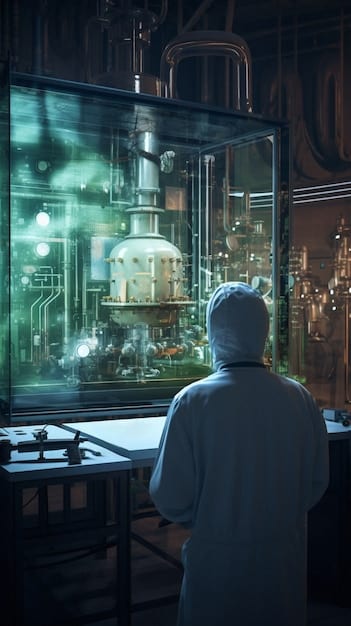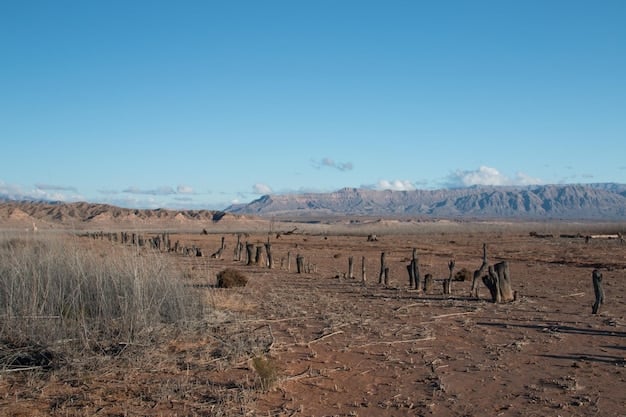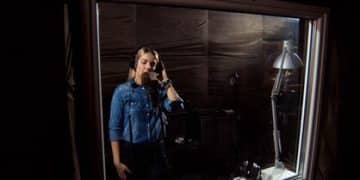Unseen Sets of Oppenheimer: Behind the Scenes Locations

Discover the hidden locations and intricate sets that played crucial roles in shaping the narrative and atmosphere of Christopher Nolan’s “Oppenheimer,” offering a unique behind-the-scenes glimpse into the film’s production.
Christopher Nolan’s “Oppenheimer” captivated audiences with its gripping portrayal of J. Robert Oppenheimer and the development of the atomic bomb. But beyond the stellar performances and intense drama, the film’s authentic locations and meticulously crafted sets played a vital, yet often unseen, role in bringing this historical narrative to life. Let’s embark on the unseen sets of Oppenheimer: A behind-the-scenes tour of the locations that shaped the ending.
The Vision Behind the Locations
Christopher Nolan is renowned for his commitment to practical effects and real locations, aiming to immerse the audience in the story’s world. In “Oppenheimer,” this approach was crucial for authentically portraying the historical events and environments.
Authenticity as a Guiding Principle
For Nolan, using real locations wasn’t just about visual accuracy; it was about capturing the essence and spirit of the time. This involved extensive research to identify places that still resembled their mid-20th-century counterparts.
The Challenge of Finding Untouched Locales
The production team faced the challenge of finding locations that hadn’t been significantly altered by modern development. This required scouting in remote areas and working with historical societies to preserve the integrity of the settings.
- Emphasis on historical accuracy to enhance the film’s credibility.
- Commitment to practical effects over CGI for a more realistic depiction.
- Scouting for locations that retained their mid-20th-century appearance.
- Collaboration with historical societies to ensure authenticity.
Nolan’s dedication to authenticity elevates “Oppenheimer” beyond a mere historical drama, transforming it into an immersive experience that transports viewers back to a pivotal moment in history. The locations themselves become characters, adding depth and resonance to the narrative. The choice to use real settings over relying on visual effects underscores the director’s commitment to providing an honest and visceral portrayal of a complex story. This approach not only enhances the film’s aesthetic appeal but also reinforces its thematic exploration of the past, encouraging audiences to connect with history on a more personal level.
Los Alamos: Recreating the Secret City
Los Alamos, the isolated mesa where the Manhattan Project unfolded, was a central location for “Oppenheimer.” Recreating this secret city required meticulous attention to detail and a deep understanding of its historical significance.

New Mexico as a Stand-In
While the actual Los Alamos has changed over the years, the production found areas in New Mexico that closely resembled the original wartime laboratory and residential areas.
The Barracks and Laboratories
The sets included recreations of the makeshift barracks where scientists lived and the rudimentary laboratories where they conducted groundbreaking research.
- Utilizing New Mexico’s landscapes to replicate the isolated feel of Los Alamos.
- Recreating the living and working spaces of the Manhattan Project scientists.
- Employing vintage scientific equipment to enhance the authenticity of the laboratories.
- Capturing the sense of urgency and secrecy that permeated Los Alamos.
The meticulous recreation of Los Alamos serves as more than just a backdrop; it immerses the audience in the unique environment that fostered both scientific innovation and moral complexities. By grounding the narrative in a tangible and authentic setting, Nolan amplifies the thematic tension between progress and consequence, inviting viewers to contemplate the legacy of the Manhattan Project. The sets transform into a visual metaphor for the isolation and pressure experienced by the scientists, providing a deeper understanding of the human drama at the core of the story. Nolan’s attention to detail ensures that every element, from the scientific instruments to the living quarters, contributes to a cohesive and compelling portrayal of this pivotal chapter in history.
The Trinity Test Site: Ground Zero
The Trinity test site, where the first atomic bomb was detonated, represents a crucial and haunting moment in history. Filming this sequence presented unique challenges and required careful consideration of the location’s impact.
Recreating the Atmosphere of the Test
The production team worked to recreate the barren landscape and the tense atmosphere that surrounded the test, using practical effects to simulate the explosion.
Safety and Respect
Filming at or near the actual site demanded a high level of safety and respect for the historical significance and potential environmental concerns.

- Using practical effects to simulate the atomic explosion without relying on CGI.
- Ensuring the safety of the cast and crew during the filming of the Trinity test sequence.
- Treating the historical site with the utmost respect and consideration.
- Recreating the barren landscape to emphasize the isolation and gravity of the event.
The recreation of the Trinity test site transcends mere historical reproduction, becoming a symbolic representation of the profound impact of the atomic bomb. By meticulously recreating the barren landscape and simulating the pre-dawn tension, Nolan invites viewers to confront the gravity of this pivotal moment in history. The choice to use practical effects over CGI underscores the film’s commitment to realism, providing a visceral and unsettling depiction of the event. The inclusion of small figures against the vast backdrop amplifies the human element, reminding audiences of the individuals whose actions led to such momentous consequences. The scene becomes a powerful visual meditation on the themes of ambition, destruction, and the moral responsibility that accompanies scientific progress. In capturing the Trinity test, Nolan not only recreates history but also creates an opportunity for audiences to reflect on its lasting legacy.
Behind Closed Doors: Filming the Interrogation Scenes
Many pivotal moments in “Oppenheimer” occur in closed rooms, during interrogations and hearings. The locations for these scenes were carefully selected to enhance the tension and psychological drama.
Finding the Right Spaces
The production team sought out rooms with specific architectural features and historical character to create the appropriate atmosphere for these intense encounters.
Using Light and Shadow
Cinematography played a crucial role in these scenes, using light and shadow to highlight the emotional states of the characters and the power dynamics at play.
For the interrogation scenes in “Oppenheimer,” the selection of filming locations was far more than a matter of logistical convenience; it was a deliberate artistic choice designed to amplify the film’s psychological depth. The production team meticulously scouted for rooms that possessed specific architectural traits and historical ambiance, carefully considering how these elements could contribute to the overall sense of tension. The deliberate use of light and shadow became a potent tool, underscoring the emotional nuances of each character while also emphasizing the power dynamics inherent in the interrogation process. The carefully crafted visual language transformed these enclosed spaces into metaphorical arenas where psychological battles unfolded, enhancing the emotional impact on the audience. By marrying location, cinematography, and performance, Nolan crafted scenes that were not only visually compelling but also profoundly insightful into the complex inner workings of the characters.
Universities and Institutions: The Academic World
Oppenheimer’s life was deeply intertwined with the academic world, and the film features scenes set in universities and research institutions. These locations needed to convey the intellectual atmosphere of the time.
Capturing the Essence of Academic Life
The production aimed to recreate the look and feel of university campuses and research facilities from the mid-20th century, from lecture halls to libraries.
The Importance of Detail
Details such as period-appropriate books, furniture, and equipment were crucial for creating an authentic academic environment.
- Recreating university campuses and research facilities from the mid-20th century.
- Attention to detail in the set design to convey the intellectual atmosphere.
- Using lecture halls and libraries to capture the essence of academic life.
- Ensuring period-appropriate books, furniture, and equipment.
Within “Oppenheimer,” the careful depiction of universities and research institutions serves as more than just a backdrop; it’s an integral part of the narrative. By faithfully recreating the look and feel of academic life in the mid-20th century, from lecture halls to libraries, Nolan underscores the crucial role that knowledge and intellectual curiosity played in shaping the protagonist’s journey. Attention to detail in the set design, with period-appropriate books, furniture, and equipment, helps to immerse the audience in the academic environment, making it feel both authentic and intellectually stimulating. These locations become symbolic of the wider pursuit of knowledge and the scientific advancements that defined the era. They serve as places of both inspiration and moral complexity, highlighting the ethical dilemmas that arise when knowledge is applied to powerful ends. Through these settings, Nolan invites viewers to consider the interplay between intellectual exploration and moral responsibility.
The Open Road: Travel and Isolation
The vast landscapes of the American West also feature prominently in “Oppenheimer,” representing both the freedom and the isolation experienced by the characters.
Conveying a Sense of Scale
Wide shots of the open road and expansive landscapes were used to convey the scale of the American West and the characters’ journey.
Symbolism of Isolation
These locations also served to symbolize the isolation and internal struggles of Oppenheimer and others involved in the Manhattan Project.
- Using wide shots to convey the scale of the American West.
- Symbolizing the isolation and internal struggles of the characters.
- Contrasting the vast landscapes with the claustrophobic environments of the laboratories.
- Emphasizing the characters’ journey, both physical and emotional.
The use of the American West’s vast landscapes within “Oppenheimer” transcends mere scenic beauty, serving as a powerful thematic element. The wide shots, capturing the expansive vistas of the open road, evoke both the promise of freedom and the stark reality of isolation. These locations underscore the physical and emotional journey of the characters, particularly Oppenheimer, whose internal struggles are mirrored in the desolate beauty of the surroundings. The contrast between these open spaces and the claustrophobic setting of the laboratories highlights the complex paradoxes inherent in the narrative – the tension between scientific progress and personal sacrifice, between intellectual freedom and moral confinement. As the characters traverse these landscapes, they are not only moving through physical space but also navigating the intricate terrain of their own consciences. This interplay between character and setting enriches the film’s emotional depth, inviting viewers to contemplate the profound impact of the choices made in the pursuit of scientific achievement.
| Key Point | Brief Description |
|---|---|
| 📍 Authentic Locations | Real places enhance the film’s historical credibility. |
| 🧪 Recreated Sets | Los Alamos and Trinity Test Site brought to life with detail. |
| 🏛️ Academic Settings | Universities emphasize intellectual environment. |
| 🌄 Western Landscapes | Open roads mirror characters’ isolation and journey. |
Frequently Asked Questions
▼
Nolan’s commitment to authenticity aimed to immerse the audience in the historical context, enhancing the film’s credibility and impact through genuine environments.
▼
Areas in New Mexico closely resembling the original wartime laboratory were used, with meticulous set design to recreate the barracks and research facilities.
▼
Recreating the barren landscape required careful consideration of safety and respect for the site’s historical significance, with practical effects simulating the explosion.
▼
Specific architectural features and the use of light and shadow created tension, highlighting the emotional states of the characters and the power dynamics involved.
▼
The universities showcase the intellectual environment and academic life crucial to Oppenheimer, emphasizing the pursuit of knowledge and scientific innovation of the time.
Conclusion
Exploring the unseen sets of “Oppenheimer” reveals the meticulous craftsmanship and dedication to authenticity that defined Christopher Nolan’s vision. From the recreated laboratories of Los Alamos to the vast landscapes of the American West, each location played a vital role in bringing this historical drama to life, immersing audiences in a pivotal moment in history.
![Unveiling the Secrets: Costume Design in [Show Title]'s Finale Unveiling the Secrets: Costume Design in [Show Title]'s Finale - Cover Image](https://endingnew.com/wp-content/uploads/2025/06/endingnew.com_13_1749558836_c21c77d2_cover-360x180.jpg)
![The Music Behind the Magic: Unpacking the [Movie Title] Score The Music Behind the Magic: Unpacking the [Movie Title] Score - Cover Image](https://endingnew.com/wp-content/uploads/2025/06/endingnew.com_13_1749558769_5379e62d_cover-360x180.jpg)



![From Script to Screen: Unveiling [Show Title]'s Finale Revisions From Script to Screen: Unveiling [Show Title]'s Finale Revisions - Cover Image](https://endingnew.com/wp-content/uploads/2025/06/endingnew.com_13_1749558769_1f25bec4_cover-360x180.jpg)